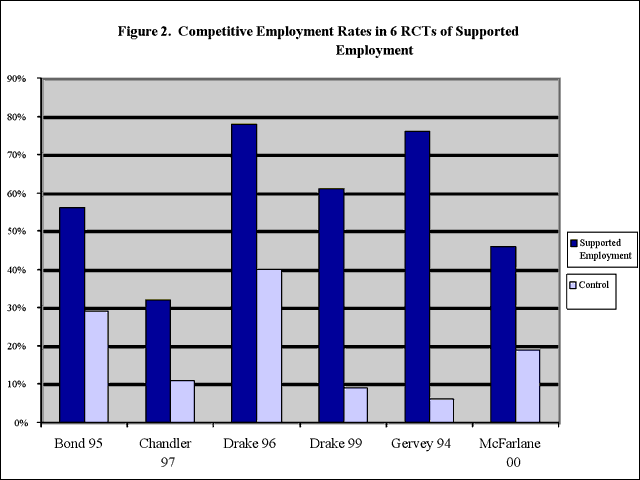Using The Supported Employment Fidelity Scale: An Introduction for Practitioners
duration: 2 min. 8 sec.
slide 4

This graph demonstrates that consumers enrolled in supported employment have competitive employment rates double or triple that of other vocational services. All six studies reported significant gains in obtaining and keeping employment for individuals enrolled in supported employment. An example of these gains is demonstrated by calculating the mean percent of individuals achieving competitive employment outcomes. The mean is determined by taking the sum total of participants who achieved a competitive employment outcome using a specified service and dividing it by the sum total of all participants who received that service.
For the six studies shown in the graph, a mean of 58 percent of supported employment clients achieved competitive employment at some time over a 12- to 18-month period, compared with 21 percent of the control group. The control group received a range of alternative vocational interventions, including skill training, sheltered work, and vocational counseling as steps toward competitive job placements.
I would like to call your attention to the data represented in the graph from a study conducted by Dr. Robert Drake in 1996. The bar graph from this 1996 study provides a representative example of the overall findings from all six studies. More specifically, a rural New Hampshire community mental health center developed a supported employment program to replace day treatment services. The research compared this community mental health center’s conversion site with a nearby site that continued day treatment along with traditional brokered vocational services. The competitive employment rate increased substantially at the conversion site, while the rate of competitive employment was unchanged at the comparison site. Another important finding was that adverse outcomes such as hospitalization, incarceration, and dropouts did not increase at the conversion site. In addition, clients in the supported employment study group, their families, and mental health staff had favorable reactions to the conversion, although a minority mentioned loss of social contact as a drawback. Replacing day treatment with supported employment in this study also led to cost savings.